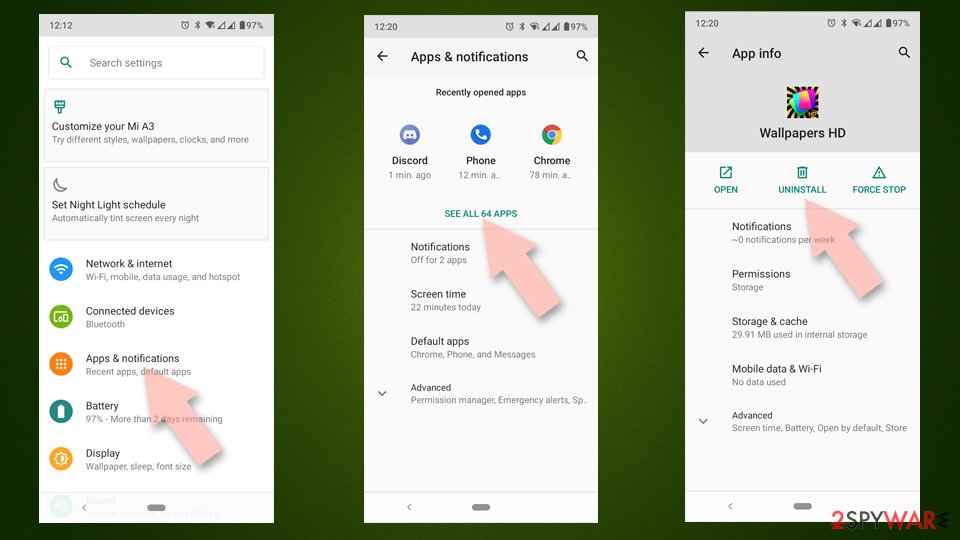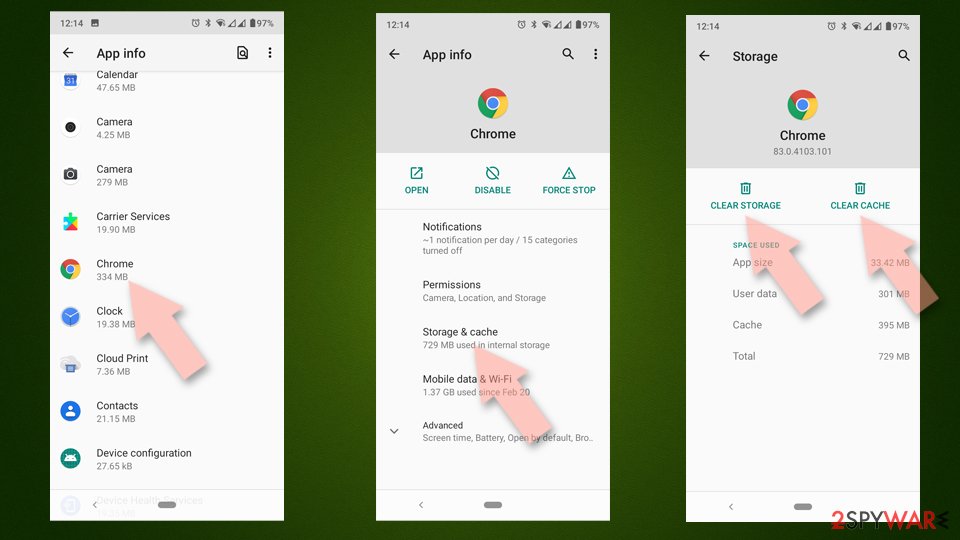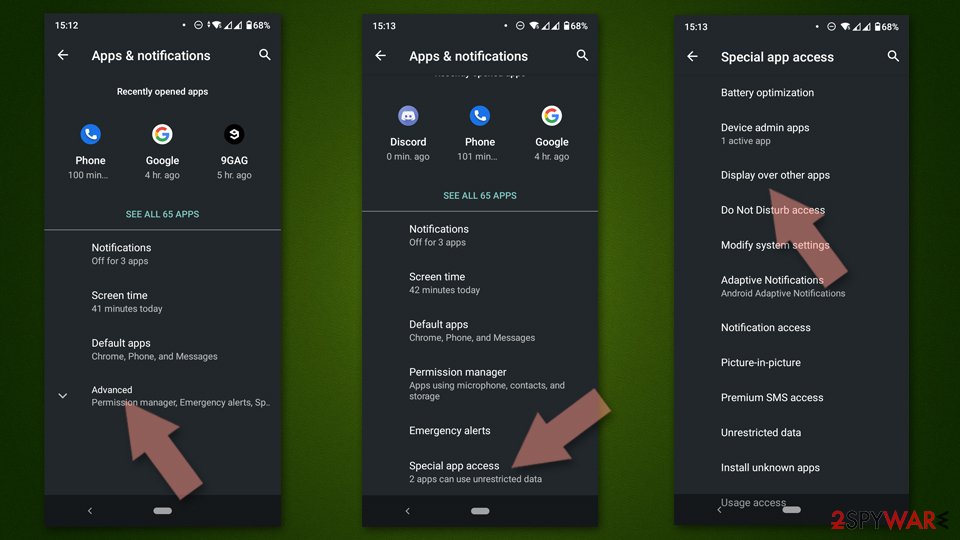Captcha Reverse (Removal Guide) - Chrome, Firefox, IE, Edge
Captcha Reverse Removal Guide
What is Captcha Reverse?
CaptchaReverse – a deceitful portal that will bombard your device with ads if you accept its notifications

Captchareverse.com is the address of an untrustworthy website to which Windows, Mac, and Android users can be redirected if they have an adware infection. If you end up on this page, please don't accept its notifications. Otherwise, ads will start popping up directly on your screen or desktop.
Ads from this push notification virus are deceptive as they usually have nothing in common with the portals you will be redirected to if you press them. Furthermore, you could end up on any of its affiliated portals without clicking on anything if a sudden redirect is triggered.
This article contains a brief summary of Captcha Reverse virus and instructions to remove its notifications from your browsers (Chrome, Safari, etc.). Moreover, we've added free tutorials on how to eliminate the adware that caused the initial redirect and system recovery options if your device's performance is reduced or it's exhibiting any abnormal behavior.
| name | Captcha Reverse |
|---|---|
| Type | Adware, redirect virus, PUP[1] |
| Purpose | Trick visitors into accepting notifications so it could deliver ads of affiliated sites directly to your desktop or screen |
| URL address | Captchareverse.com |
| IP address | 5.8.34.12 |
| Symptoms | Ads in the form of notifications appearing constantly; the device performance is diminished; browsing speed is reduced; new tabs are opened with sites that you didn't intend to visit |
| Risks | PUP installation, privacy issues, malware infections, monetary losses |
| Elimination | If you accepted notifications from the article's culprit, use our free instructions at the bottom of the page to remove them. Then scan your device with proper security tools to get rid of any PUPs or malware |
| System health check | To eliminate any residual files, tracking cookies, and repair all system-related inconsistencies that the push notification virus caused, use the FortectIntego system diagnostics tool |
Developers of potentially unwanted programs (browser hijackers, adware, etc.) often promote one another. That's why you could be redirected to treacherous pages with dangerous content like N19.biz virus, Acceptww.com virus, Nbryb.com virus, and so on. These websites exploit the legitimate service of push notifications to deliver ads and cause redirects.
Captcha Reverse infection does the same. It doesn't deliver any sports updates, breaking news, or anything worthwhile. It shows deceptive ads that, when clicked, redirect to affiliated pages. Some of them might be harmless, but others might have dangerous contents, such as:
- PUPs,
- malware,
- porn,
- tech support scams,
- gambling, etc.
What's worse, you could be exposed to any of these dangerous affiliated websites on-demand if a sudden redirect is triggered. That's because PUP developers care only about getting paid, not their user safety or privacy. Thus push notifications should be enabled only on pages that you frequently visit and trust.
Although PUPs are deemed less dangerous than malware, they should not be installed on any device. Browser hijackers, adware, and similar junkware could still endanger both you and your device by acting as a bridge to severe infections, like ransomware, Trojans, etc.
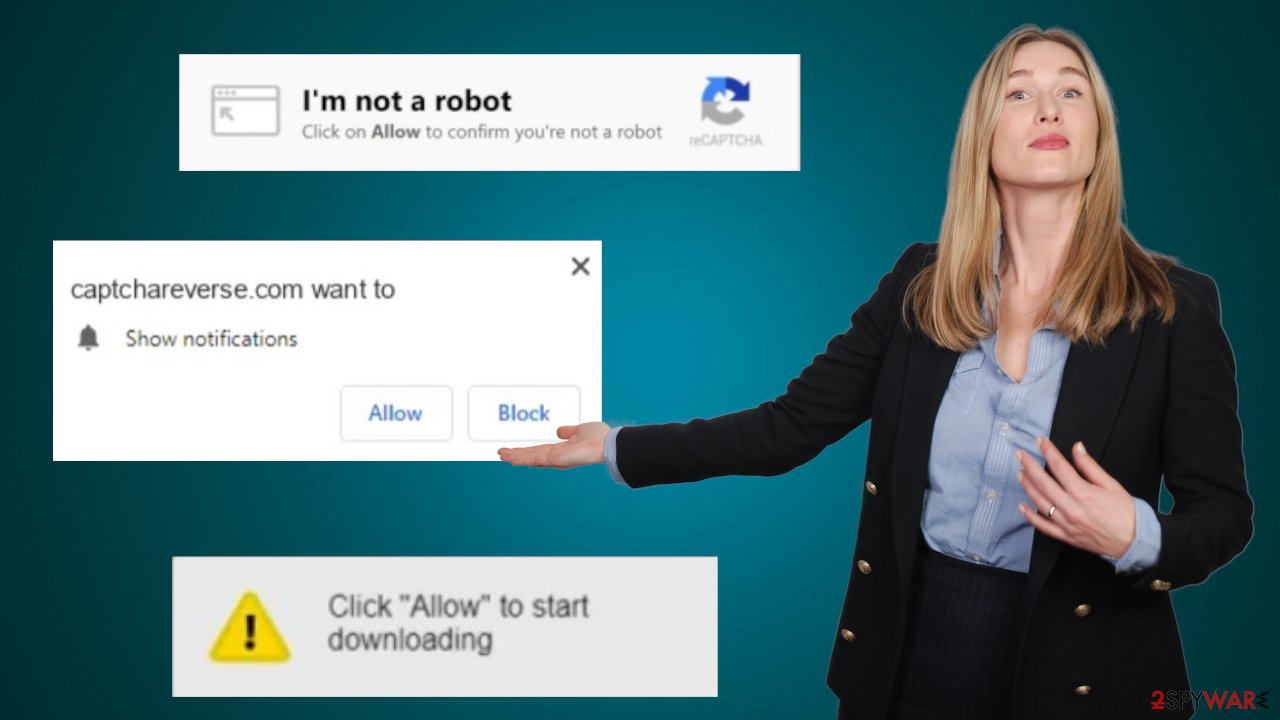
That's why you have to remove it ASAP. According to IT experts,[2] the best way to do this is to perform a full system scan with reliable anti-malware software. Free security tools such as Malwarebytes or SpyHunter 5Combo Cleaner will automatically eliminate any cyber threat that found its way to your device.
After the removal is done, use our removal guides below to delete Captcha Reverse notifications from your browsers. And lastly, we highly recommend running system diagnostics with the time-tested FortectIntego system repair tool to fix all system irregularities, so your device doesn't exhibit any abnormal behavior, such as freezing, severe lag, BSoDs,[3] and so on.
Uninstall Flash Player and don't update it to avoid PUP infections
Browser hijackers, unwanted toolbars, adware, and other PUPs can be delivered in many different ways, from software bundles to deceptive ads. Our team has determined that one of the most popular PUP spreading techniques is via fake Flash Player updates that can be seen on various shady or hacked websites.
Adobe discontinued this software on December 31, 2020. The company issued a statement urging everyone to uninstall Flash Player from their devices for security reasons. But since many people still don't know that, cybercriminals are exploiting it.
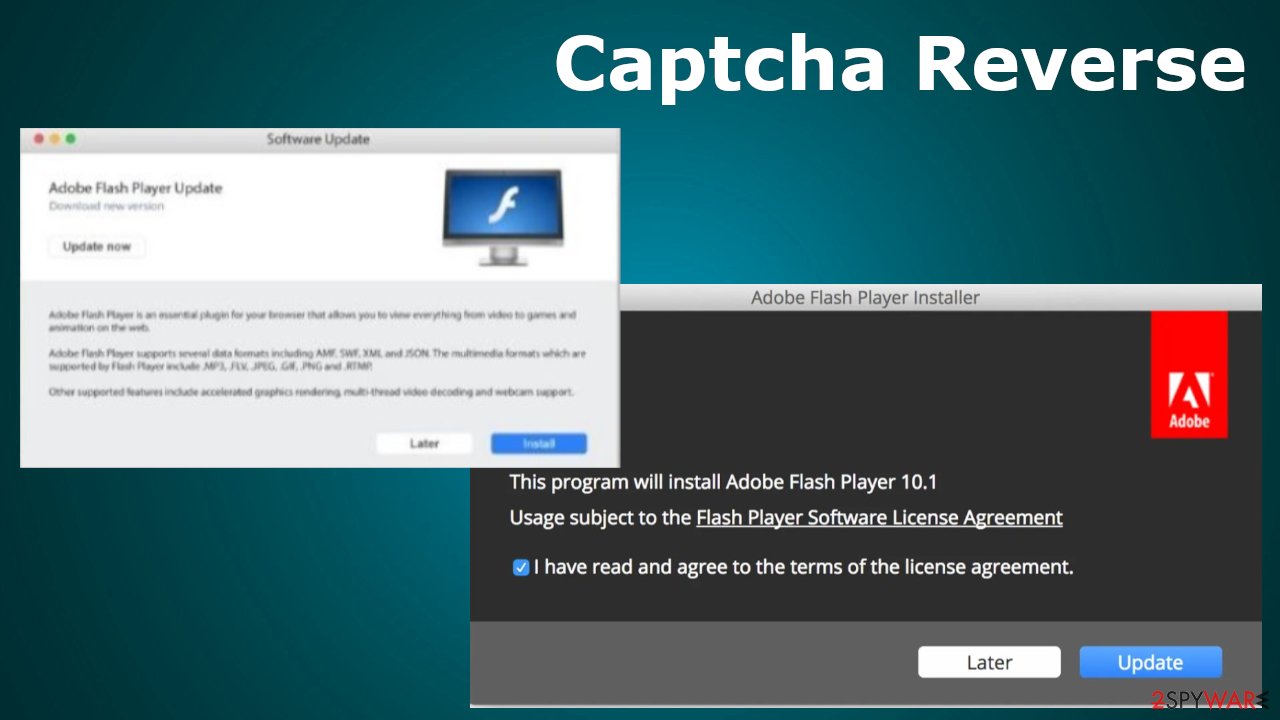
They develop ads, prompts, sometimes even the whole website to help them distribute their vile creations. Fake Flash Player could contain pesky PUPs and hazardous malware, such as ransomware, keyloggers, etc. So if you ever see a prompt urging to update or install Flash Player, please be advises that the suggested download is malicious.
Comprehensive guide to remove Captcha Reverse from your browser and adware from your device
Cybercriminals are exploiting the legitimate push notification service by tricking people into pressing the Allow button and displaying them ads directly on the desktop or screen afterward. Thus internet users have to stay aware of sites like Captchareverse.com and not accept their notifications.
First, you have to perform a full system scan with a proper anti-malware tool to begin the removal process. Such software is a must these days, as cyberattacks are on the rise, and they won't slow down. Reliable security software will block dangerous websites and prevent your device from getting infected with severe malware.
After you remove adware, PUPs, and any other suspicious apps or files, you can use our free guides below to erase notifications from Captcha Reverse. Once all infections are gone, run system diagnostics with compatible software to restore your device to a pre-contamination phase and ensure it runs without any hitches.
You may remove virus damage with a help of FortectIntego. SpyHunter 5Combo Cleaner and Malwarebytes are recommended to detect potentially unwanted programs and viruses with all their files and registry entries that are related to them.
Getting rid of Captcha Reverse. Follow these steps
Stop browser notifications
Remove unwanted notifications from Google Chrome (desktop):
- Open Google Chrome browser and go to Menu > Settings.
- Scroll down and click on Advanced.
- Locate Privacy and security section and pick Site Settings > Notifications.

- Look at the Allow section and look for a suspicious URL.
- Click the three vertical dots next to it and pick Block. This should remove unwanted notifications from Google Chrome.

Remove unwanted notifications from Google Chrome (Android):
- Open Google Chrome and tap on Settings (three vertical dots).
- Select Notifications.
- Scroll down to the Sites section.
- Locate the unwanted URL and toggle the button to the left (Off setting).

Remove unwanted notifications from Mozilla Firefox:
- Open Mozilla Firefox and go to Menu > Options.
- Click on Privacy & Security section.
- Under Permissions, you should be able to see Notifications. Click the Settings button next to it.

- In the Settings – Notification Permissions window, click on the drop-down menu by the URL in question.
- Select Block and then click on Save Changes. This should remove unwanted notifications from Mozilla Firefox.

Remove unwanted notifications from Safari:
- Click on Safari > Preferences…
- Go to the Websites tab and, under General, select Notifications.
- Select the web address in question, click the drop-down menu and select Deny.

Remove unwanted notifications from MS Edge:
- Open Microsoft Edge, and click the Settings and more button (three horizontal dots) at the top-right of the window.
- Select Settings and then go to Advanced.
- Under Website permissions, pick Manage permissions and select the URL in question.

- Toggle the switch to the left to turn notifications off on Microsoft Edge.

Remove unwanted notifications from MS Edge (Chromium):
- Open Microsoft Edge, and go to Settings.
- Select Site permissions.
- Go to Notifications on the right.
- Under Allow, you will find the unwanted entry.
- Click on More actions and select Block.

Remove unwanted notifications from Internet Explorer:
- Open Internet Explorer, and click on the Gear icon at the top-right of the window.
- Select Internet options and go to the Privacy tab.
- In the Pop-up Blocker section, click on Settings.
- Locate web address in question under Allowed sites and pick Remove.

Uninstall from Windows
Instructions for Windows 10/8 machines:
- Enter Control Panel into Windows search box and hit Enter or click on the search result.
- Under Programs, select Uninstall a program.

- From the list, find the entry of the suspicious program.
- Right-click on the application and select Uninstall.
- If User Account Control shows up, click Yes.
- Wait till uninstallation process is complete and click OK.

If you are Windows 7/XP user, proceed with the following instructions:
- Click on Windows Start > Control Panel located on the right pane (if you are Windows XP user, click on Add/Remove Programs).
- In Control Panel, select Programs > Uninstall a program.

- Pick the unwanted application by clicking on it once.
- At the top, click Uninstall/Change.
- In the confirmation prompt, pick Yes.
- Click OK once the removal process is finished.
Delete from macOS
Remove items from Applications folder:
- From the menu bar, select Go > Applications.
- In the Applications folder, look for all related entries.
- Click on the app and drag it to Trash (or right-click and pick Move to Trash)

To fully remove an unwanted app, you need to access Application Support, LaunchAgents, and LaunchDaemons folders and delete relevant files:
- Select Go > Go to Folder.
- Enter /Library/Application Support and click Go or press Enter.
- In the Application Support folder, look for any dubious entries and then delete them.
- Now enter /Library/LaunchAgents and /Library/LaunchDaemons folders the same way and terminate all the related .plist files.

Uninstall from Android
Uninstall unwanted programs from Android device:
- Go to Settings -> Apps/Applications.
- Expand the full list of the installed apps.
- Scroll through the list and tap on a suspicious application once.
- Tap on it and select Uninstall.

- Reboot the device.
Clear Storage and data files on Android from Google Chrome or other apps:
- Go to Settings > Apps/Applications.
- Expand the full list of the installed apps.
- Tap on Chrome and select Storage & cache.
- Clear storage and clear cache of the app.

If you are seeing ads on top of other apps but are not sure what is causing it, perform the following steps:
- Go to Apps/Applications.
- Tap Advanced.
- Select Special App access.
- Tap on Display over other apps.

- Eliminate apps with these access rights enabled.
Remove from Microsoft Edge
Delete unwanted extensions from MS Edge:
- Select Menu (three horizontal dots at the top-right of the browser window) and pick Extensions.
- From the list, pick the extension and click on the Gear icon.
- Click on Uninstall at the bottom.

Clear cookies and other browser data:
- Click on the Menu (three horizontal dots at the top-right of the browser window) and select Privacy & security.
- Under Clear browsing data, pick Choose what to clear.
- Select everything (apart from passwords, although you might want to include Media licenses as well, if applicable) and click on Clear.

Restore new tab and homepage settings:
- Click the menu icon and choose Settings.
- Then find On startup section.
- Click Disable if you found any suspicious domain.
Reset MS Edge if the above steps did not work:
- Press on Ctrl + Shift + Esc to open Task Manager.
- Click on More details arrow at the bottom of the window.
- Select Details tab.
- Now scroll down and locate every entry with Microsoft Edge name in it. Right-click on each of them and select End Task to stop MS Edge from running.

If this solution failed to help you, you need to use an advanced Edge reset method. Note that you need to backup your data before proceeding.
- Find the following folder on your computer: C:\\Users\\%username%\\AppData\\Local\\Packages\\Microsoft.MicrosoftEdge_8wekyb3d8bbwe.
- Press Ctrl + A on your keyboard to select all folders.
- Right-click on them and pick Delete

- Now right-click on the Start button and pick Windows PowerShell (Admin).
- When the new window opens, copy and paste the following command, and then press Enter:
Get-AppXPackage -AllUsers -Name Microsoft.MicrosoftEdge | Foreach {Add-AppxPackage -DisableDevelopmentMode -Register “$($_.InstallLocation)\\AppXManifest.xml” -Verbose

Instructions for Chromium-based Edge
Delete extensions from MS Edge (Chromium):
- Open Edge and click select Settings > Extensions.
- Delete unwanted extensions by clicking Remove.

Clear cache and site data:
- Click on Menu and go to Settings.
- Select Privacy, search and services.
- Under Clear browsing data, pick Choose what to clear.
- Under Time range, pick All time.
- Select Clear now.

Reset Chromium-based MS Edge:
- Click on Menu and select Settings.
- On the left side, pick Reset settings.
- Select Restore settings to their default values.
- Confirm with Reset.

Remove from Mozilla Firefox (FF)
Remove dangerous extensions:
- Open Mozilla Firefox browser and click on the Menu (three horizontal lines at the top-right of the window).
- Select Add-ons.
- In here, select unwanted plugin and click Remove.

Reset the homepage:
- Click three horizontal lines at the top right corner to open the menu.
- Choose Options.
- Under Home options, enter your preferred site that will open every time you newly open the Mozilla Firefox.
Clear cookies and site data:
- Click Menu and pick Settings.
- Go to Privacy & Security section.
- Scroll down to locate Cookies and Site Data.
- Click on Clear Data…
- Select Cookies and Site Data, as well as Cached Web Content and press Clear.

Reset Mozilla Firefox
If clearing the browser as explained above did not help, reset Mozilla Firefox:
- Open Mozilla Firefox browser and click the Menu.
- Go to Help and then choose Troubleshooting Information.

- Under Give Firefox a tune up section, click on Refresh Firefox…
- Once the pop-up shows up, confirm the action by pressing on Refresh Firefox.

Remove from Google Chrome
Delete malicious extensions from Google Chrome:
- Open Google Chrome, click on the Menu (three vertical dots at the top-right corner) and select More tools > Extensions.
- In the newly opened window, you will see all the installed extensions. Uninstall all the suspicious plugins that might be related to the unwanted program by clicking Remove.

Clear cache and web data from Chrome:
- Click on Menu and pick Settings.
- Under Privacy and security, select Clear browsing data.
- Select Browsing history, Cookies and other site data, as well as Cached images and files.
- Click Clear data.

Change your homepage:
- Click menu and choose Settings.
- Look for a suspicious site in the On startup section.
- Click on Open a specific or set of pages and click on three dots to find the Remove option.
Reset Google Chrome:
If the previous methods did not help you, reset Google Chrome to eliminate all the unwanted components:
- Click on Menu and select Settings.
- In the Settings, scroll down and click Advanced.
- Scroll down and locate Reset and clean up section.
- Now click Restore settings to their original defaults.
- Confirm with Reset settings.

Delete from Safari
Remove unwanted extensions from Safari:
- Click Safari > Preferences…
- In the new window, pick Extensions.
- Select the unwanted extension and select Uninstall.

Clear cookies and other website data from Safari:
- Click Safari > Clear History…
- From the drop-down menu under Clear, pick all history.
- Confirm with Clear History.

Reset Safari if the above-mentioned steps did not help you:
- Click Safari > Preferences…
- Go to Advanced tab.
- Tick the Show Develop menu in menu bar.
- From the menu bar, click Develop, and then select Empty Caches.

After uninstalling this potentially unwanted program (PUP) and fixing each of your web browsers, we recommend you to scan your PC system with a reputable anti-spyware. This will help you to get rid of Captcha Reverse registry traces and will also identify related parasites or possible malware infections on your computer. For that you can use our top-rated malware remover: FortectIntego, SpyHunter 5Combo Cleaner or Malwarebytes.
How to prevent from getting adware
Protect your privacy – employ a VPN
There are several ways how to make your online time more private – you can access an incognito tab. However, there is no secret that even in this mode, you are tracked for advertising purposes. There is a way to add an extra layer of protection and create a completely anonymous web browsing practice with the help of Private Internet Access VPN. This software reroutes traffic through different servers, thus leaving your IP address and geolocation in disguise. Besides, it is based on a strict no-log policy, meaning that no data will be recorded, leaked, and available for both first and third parties. The combination of a secure web browser and Private Internet Access VPN will let you browse the Internet without a feeling of being spied or targeted by criminals.
No backups? No problem. Use a data recovery tool
If you wonder how data loss can occur, you should not look any further for answers – human errors, malware attacks, hardware failures, power cuts, natural disasters, or even simple negligence. In some cases, lost files are extremely important, and many straight out panic when such an unfortunate course of events happen. Due to this, you should always ensure that you prepare proper data backups on a regular basis.
If you were caught by surprise and did not have any backups to restore your files from, not everything is lost. Data Recovery Pro is one of the leading file recovery solutions you can find on the market – it is likely to restore even lost emails or data located on an external device.
- ^ Chris Hoffman. PUPs Explained: What is a “Potentially Unwanted Program”?. Howtogeek. Online technology magazine.
- ^ Virusi. Virusi. Spyware news and security.
- ^ Blue Screen of Death (BSoD). Techopedia. Professional it insights.















